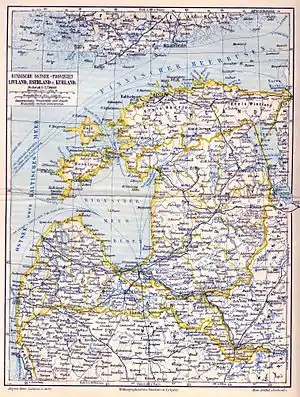Estonianization
Estonianization or Estonianisation is the changing of one's personal names from other languages into Estonian, or the development of Estonian language, culture and identity within educational and other state institutions through various programs.

Family names
Before 1920, some fifty percent of Estonian surnames were of foreign origin.[1] At the beginning of the 1930s, president Konstantin Päts introduced a nationwide Estonianization program for family names. During this campaign thousands of Estonian citizens living in Estonia voluntarily changed their original family names.
Notable estonianized names
- Karl August Einbund → Kaarel Eenpalu
- Gerhardt Esperk → Ants Eskola
- Harald Rudolf Klein → Ruut Tarmo
- Hans Laipman → Ants Laikmaa
- Kristjan Trossmann → Kristjan Palusalu
Integration
The integration policy is aimed at strengthening of Estonian identity among the nation's populace, to develop shared values, identity, and pride in being a citizen of Estonia; with respect and acceptance of cultural differences among Estonian residents.
Education
On 14 March 2000 the Government of Estonia adopted “State Programme “Integration in Estonian society 2000-2007". Main areas and aims of the integration established by the program are linguistic-communicative, legal-political and socio-economical. The Program has four sub programs: education, the education and culture of national minorities, the teaching of Estonian to adults and social competence. The aim of the sub-programs is to be achieved via the learning of the Estonian language by children and adults.
External links
Notes and references
- George Kurman, The Development Of Written Estonian, Routledge 1997, ISBN 0-7007-0380-2, page 85
